distributed computer systems
Projects
The project, started in April 2008 under a grant from the DFG, aims to improve network calculus to aid in the dimensioning of sensor networks for environmental monitoring.
To this end, we will search for refinements to traditional network calculus that take into account the peculiarities of sensor networks, and thus try to refine the obtained bounds. Those results will be verified using an experimental testbed based on MicaZ radio motes, and CMUCam camera modules.
As a result, we plan to extend the DISCO Deterministic Network Calculator with new-found and refined techniques, on the way to a comprehensive tool for network planning and dimensioning.
Network Calculus
Work on the analytic framework will be roughly separated in two parts. First, we will refine the deterministic NC. In a second step, we will take into consideration stochastic extensions to achieve tighter, but less accurate bounds.
To support the project, we collected relevant work in the field in a Network Calculus Bibliography.
Experimental Network
With those components, we plan to develop and deploy a small-scale building surveillance system to gather real-world data, and test dimensioning results for nontrivial network loads. This will enable us to research a range of variables, like the trade-off between sending complete images vs. performing varying amounts of pre-processing on the sensors.
Some Important Publications of SeNeCa
- S. Bondorf and J. B. Schmitt. Boosting Sensor Network Calculus by Thoroughly Bounding Cross-Traffic. In Proceedings of the 34th IEEE International Conference on Computer Communications (INFOCOM 2015), Hong Kong, April 2015.
- F. Ciucu, J. B. Schmitt, and H. Wang. On Expressing Networks with Flow Transformations in Convolution-Form. In Proceedings of the 30th IEEE International Conference on Computer Communications (INFOCOM 2011), Shanghai, China, April 2011.
- J. B. Schmitt, N. Gollan, S. Bondorf, and I. Martinovic. Pay Bursts Only Once Holds for (Some) Non-FIFO Systems. In Proceedings of the 30th IEEE International Conference on Computer Communications (INFOCOM 2011), Shanghai, China, April 2011.
- W. Y. Poe, M. Beck, and J. B. Schmitt. Planning the Trajectories of Multiple Mobile Sinks in Large-Scale, Time-Sensitive WSNs. In Proceedings of the 7th IEEE International Conference on Distributed Computing in Sensor Systems (IEEE DCOSS 2011), Barcelona, Spain, Juni 2011.
- H. Wang, J. B. Schmitt, and I. Martinovic. Dynamic Demultiplexing in Network Calculus – Theory and Application. Performance Evaluation, Elsevier, 68(2):201-219, February 2011.
- P. Suriyachai, U. Roedig, A. Scott, N. Gollan, and J. B. Schmitt. Dimensioning of Time-Critical WSNs – Theory, Implementation and Evaluation. In Journal of Communications (JCM), Special Issue on New Advances in Wireless Sensor Networks, 6(5), 2011.
- A. Kiefer, N. Gollan, and J. B. Schmitt. Searching for Tight Performance Bounds in Feed-Forward Networks. In B. Muller-Clostermann, K. Echtle, und E. P. Rathgeb, editors, 15th International GI/ITG Conference on “Measurement, Modelling and Evaluation of Computing Systems” and “Dependability and Fault Tolerance” (MMB/DFT 2010), Lecture Notes in Computer Science 5987, Essen, Germany, March 2010. GI/ITG, Springer.
- J. B. Schmitt, F. A. Zdarsky, and M. Fidler. Delay Bounds under Arbitrary Multiplexing: When Network Calculus Leaves You in the Lurch .... In Proceedings of the 27th IEEE International Conference on Computer Communications (INFOCOM 2008), Phoenix, AZ, USA, April 2008.
The above and further publications for SeNeCa can also be found in Disco's publication list.
Project Staff
- Prof. Dr.-Ing. Jens B. Schmitt
- Nicos Gollan
Further Project Members
- Dr.-Ing. Steffen Bondorf
- Andreas Kiefer
- Tim Stöber
- Sebastian Bock
Contact
Please see the personal pages above for contact details.
This project page is about our 2014 ACM SIGMETRICS paper On the Relevance of Adversarial Queueing Theory in Practice on how to construct loss-efficient network adversaries. In case of questions, contact our project members Daniel S. Berger (University of Kaiserslautern), Martin Karsten (University of Waterloo), and Jens Schmitt (University of Kaiserslautern).
Summary
Adversarial Queueing Theory (AQT) [1] has been introduced to analyze the inherent stability characteristics of network topologies assuming certain scheduling policies. In particular, it has been shown for FIFO scheduling that seemingly innocent continuous packet injection strategies, where the aggregated arrival rate of requests for each link does not exceed the link capacity, can lead to unbounded queue lengths and thus, unbounded delay. Such a network configuration is termed unstable.
In reality, such patterns can be caused by misconfiguration, or unfortunate circumstances and have also been considered as a possible security threat. In fact, descriptions of network adversaries read like a cookbook for stealthy low-rate denial-of-service (DoS) attacks inducing arbitrary long queues in a target network, which in turn cause high delays and loss.
Little attention has been given to quantifying the actual threat potential of adversarial queueing effects. Although topological considerations suggest that adversarial instability may be possible in realistic network topologies [2], it is not immediately obvious whether instability effects really pose a practical threat. The most striking theoretical and "analytically convenient" assumptions of AQT are infinite buffers and a synchronized network model.
This work [3,4] attempts a new perspective on adversarial queueing effects. We investigate
- the quantitative effects of adversarial queueing in finite buffer networks (-> loss)
- with some asynchrony due to random effects in nodal processing and link delays
- and with timing variations for adversarial injections
Our results, using analysis and simulation, indicate that classical AQT examples appear harmless under realistic assumptions but for a novel class of adversaries considerably higher loss can be observed. This novel class introduces two new AQT concepts to construct loss-efficient network adversaries.
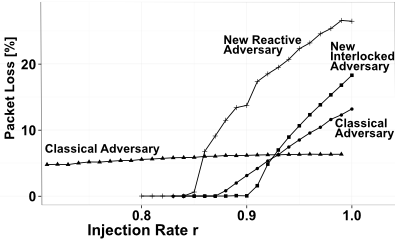
Our analysis (and simulations) also prove that the loss caused by classical adversaries (like the Baseball (BB) scenario) diminishes to irrelevant values in face of network randomization. The underlying model assumes that (instead of a deterministic network model with
uniform and synchronized network links) each channel’s delay (the corresponding server delay for processing a single
packet) follows a Weibull distributed random variable with mean one and various degrees of standard deviations up to 300%.

The new class of network adversaries (shown here, the Reactive Adversary (RA)) proves robust against randomized de-synchronization effects both in terms of variable link delays and injection synchronization.
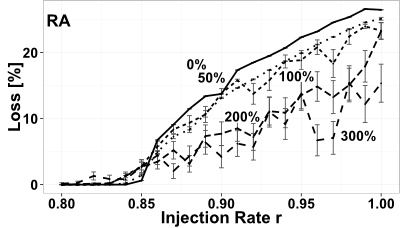
Simulation Framework and Source Code
The work in our papers [3,4] is supported by simulations that are carried out in the AQTmodel extension to the simulation framework is OMNeT++. All source code is open and available here. You will need a running OMNeT++ 4 distribution (the simulator was developed in 4.2 and 4.4 but any more recent version should work, too), sufficient hard disk space to store recorded results (on the order of 5-100 GB ,dependent on what is recorded and in which network), and TCL/TK for visualization.
Installation
This AQTmodel comes as a source library written in OMNeT++ 4.2.2 (for version v.01) and OMNeT 4.4.1 (for version v.03). You'll need to
- source setenv in the omnet folder,
- cd to the project folder,
- run make to compile first,
- and then execute ./adversarialQueueing, which will display a menu to choose the scenario to run.
In order to run different configurations (e.g., injection rates, or adversaries), no modification of the code is requires - it is a good idea to start with adjusting the main configuration file omnetpp.ini.
License
To encourage modifications and future reuse, we distribute this code under the GNU Lesser General Public License (see licenses).
This program is free software: you can redistribute it and/or modify it under the terms of the GNU Lesser General Public License as published by the Free Software Foundation, either version 3 of the License, or (at your option) any later version.
This program is distributed in the hope that it will be useful, but WITHOUT ANY WARRANTY; without even the implied warranty of MERCHANTABILITY or FITNESS FOR A PARTICULAR PURPOSE. See the GNU Lesser General Public License for more details.
Available Network Adversaries
The Baseball Adversary due to [5]

The A+ Instability Minor from [2]

The adversary by Diaz et al. [8]
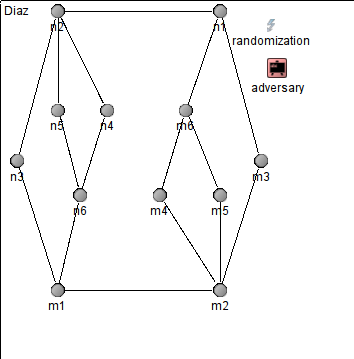
The gadget chain adversary due to Lotker et al. [7]
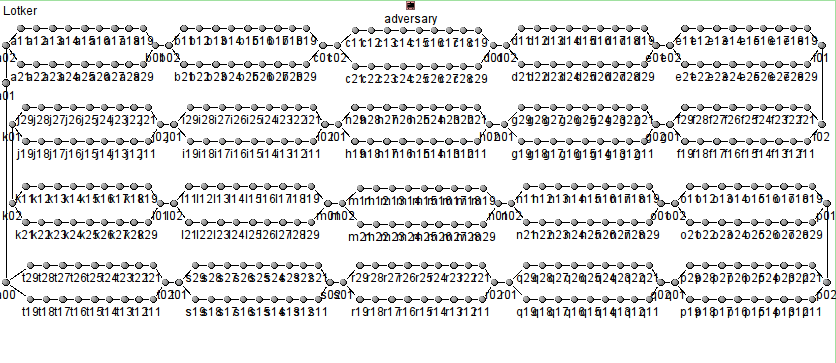
The new Interlocked Baseball Adversary proposed in [4]. The internal name (in the simulator is CE3).
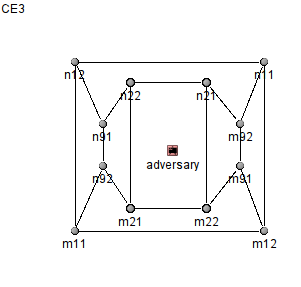
The new Reactive Adversary proposed in [4]. The internal name (in the simulator is CE7).
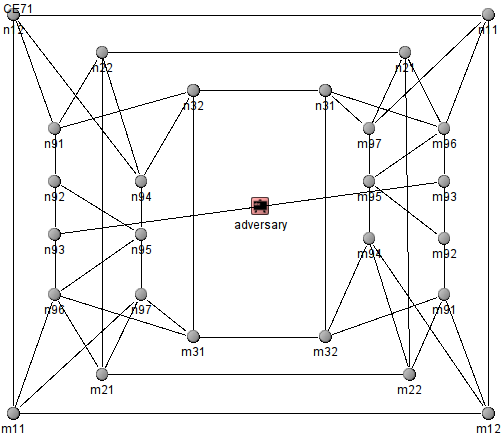
Further drafts on possible extensions like this one, which bears the internal name CE75.
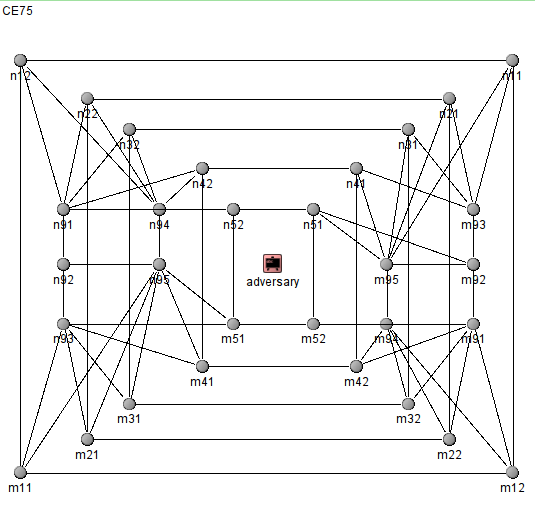
Download
Source Code: both for v.03 (paper [3] and the old version v.01 (paper [4]) is available here. The source code of v.02 is deprecated and we encourage updating to v.03.
Source Code Overview
| Folder/File | Content |
|---|---|
| ./omnetpp.ini | main configuration file, store configuration parameters for different runs |
| ./adversarialQueueing | symbolic link to main executable (only available after compilation; don't forget to add omnet to your path variable!) |
| ./messages | messages used for component internal communication and actual network packets, compile by opp_msgc |
| ./node | network nodes are composed of three layers, corresponding classes are here |
| ./networks | OMNeT++ ned representation of available networks |
| ./channelvariation | you may use OMNeT DelayChannel or DatarateChannel for deterministic AQT simulations (make sure that the time step length is matched by link traversal time; this folder gives the additional possibility to model a channel's capacity variation over time |
| ./adversaries | super class AdvancedAversary and subclasses which are examples of adversary implementations |
References and Publications
[1] A. Borodin, J. Kleinberg, P. Raghavan, M. Sudan, and D. P. Williamson. Adversarial queuing theory. Journal of the ACM, 48(1):13–38, Jan. 2001.
[2] M. Weinard. Deciding the FIFO stability of networks in polynomial time. Algorithms and Complexity, (3):81–92, 2006.
[3] DS. Berger, M. Karsten, J. Schmitt. On the Relevance of Adversarial Queueing Theory in Practice, In ACM SIGMETRICS (to appear), 2014.
[4] DS. Berger, M. Karsten, and J. Schmitt. Simulation of Adversarial Scenarios in OMNeT ++ – Putting Adversarial Queueing Theory from Its Head to Feet. In Proc. of the ICST Conference on Simulation Tools and Techniques, 2013.
[5] M. Andrews, B. Awerbuch, A. Fernandez, T. Leighton, Z. Liu, and J. Kleinberg. Universal-stability results and performance bounds for greedy contention-resolution protocols. Journal of the ACM, 48(1):39–69, Jan. 2001.
[6] R. Bhattacharjee and A. Goel. Instability of FIFO at Arbitrarily Low Rates in the Adversarial Queueing Model. SIAM Journal on Computing, 34(2):318, 2005.
[7] Z. Lotker, B. Patt-Shamir, and A. Rosen. New Stability Results for Adversarial Queuing. SIAM Journal on Computing, 33(2):286, 2004.
[8] J. Diaz, D. Koukopoulos, S. Nikoletseas, M. Serna, P. Spirakis, and D. M. Thilikos. Stability and non-stability of the FIFO protocol. In Proc. of the SPAA, pages 48–52, Crete Island, Greece, 2001. ACM.
This document is still in process and hopefully will evolve at some day into a full grown course about Stochastic Network Calculus, giving a good overview over this exciting theory. Hence, please provide feedback to This email address is being protected from spambots. You need JavaScript enabled to view it..
This First Course in Stochastic Network Calculus builds on the lecture Performance Modeling of Distributed Systems at the University of Kaiserslautern. The concepts of stochastic network calclulus parallels those of deterministic network calculus. This is why I reference on the lecture of 2011 at several points to stress these connections. This document however is thought of a stand-alone course and hence a deep study of the lecture is not necessary (but recommended).
This course contains a rather large probability primer to ensure the student can really grasp the expressions, which appear in stochastic network calculus. A student familiar with probability theory might skip this first chapter and delve directly into the stochastic network calculus. For each topic exercises are given, which can (and should) be used to strengthen the understanding of the presented definitions and theory.
What is it?
A toolbox for the stochastic network calculus (SNC) with moment-generating functions (MGFs) is implemented. It is focused on (sigma, rho)-constrained processes. It provides a list a typical stochastic network calculus arrival processes, operators, and performance bounds in order to conduct end-to-end network analyses.
The toolbox works well with JetBrains PyCharm and supports, e.g., features like type hints.
Screenshot in PyCharm:

More Information
For more information, check out the README.md on Github
Feedback
For feedback, questions, ... etc. please contact Paul Nikolaus
System Requirements
Python 3.10 or higher and all libraries in requirements.txt
Download
The code is exclusively available on Github!
What is it?
The SNC Quick Start is a simple guide on how to implement the stochastic network calculus (SNC) with moment-generating functions (MGFs).
It is a Jupyter Notebook that combines the mathematical background with an actual implementation in Python 3.
The notebook works well with VS Code (together with the "Jupyter" and the "Markdown+Math" extension) or JetBrains DataSpell.
More Information
For more information, check out the README.md on Github
Screenshot in VS Code
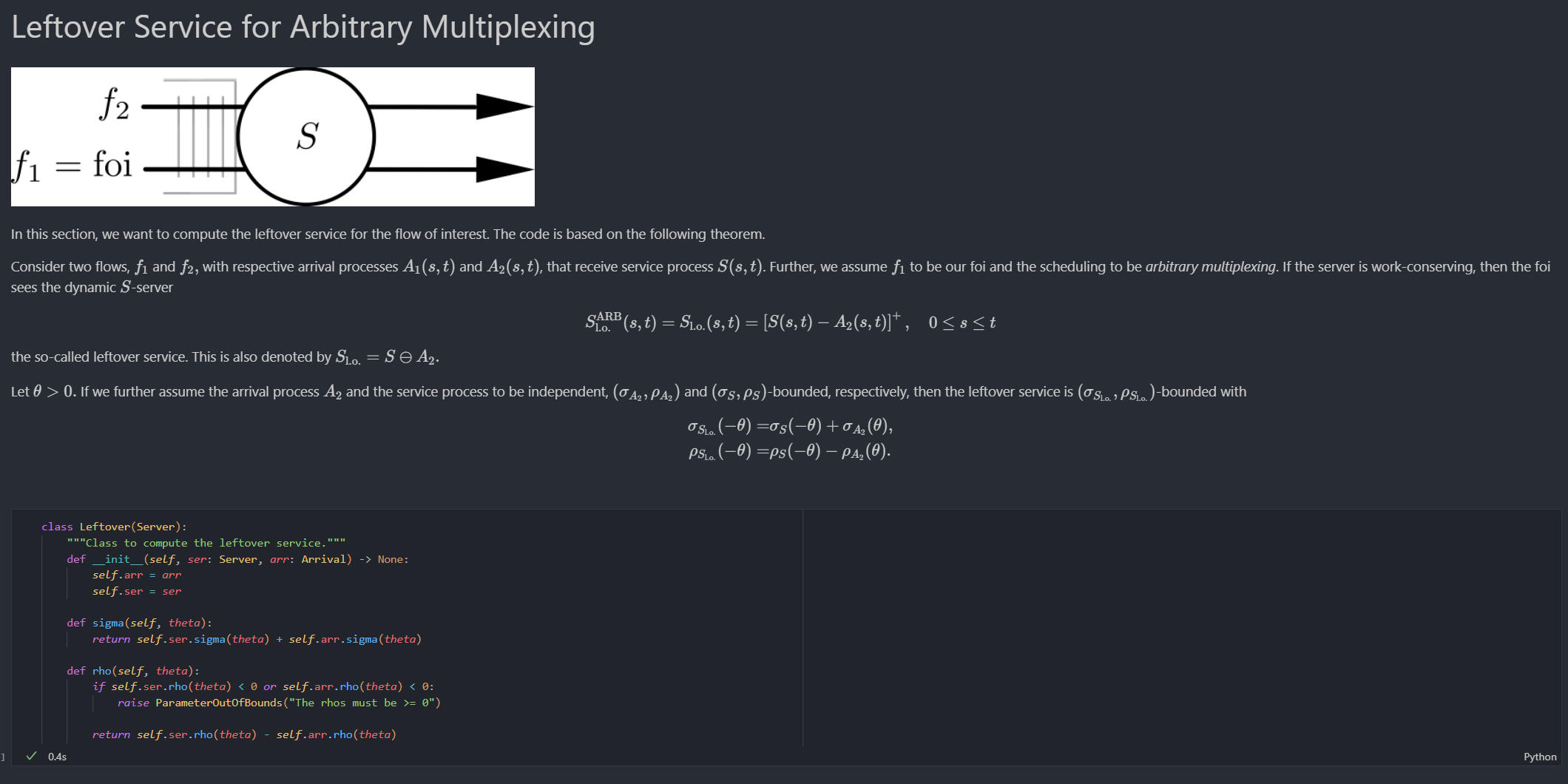
Feedback
For feedback, questions, ... etc. please contact Paul Nikolaus
System Requirements
Python 3.10 or higher and all libraries in requirements.txt
Download
The code is exclusively available on Github!
Subcategories
Write your thesis with a disco advisor
 We offer a variety of bachelor and master theses at any point in the academic year. Also check out some of our completed theses. Read more...
We offer a variety of bachelor and master theses at any point in the academic year. Also check out some of our completed theses. Read more...

